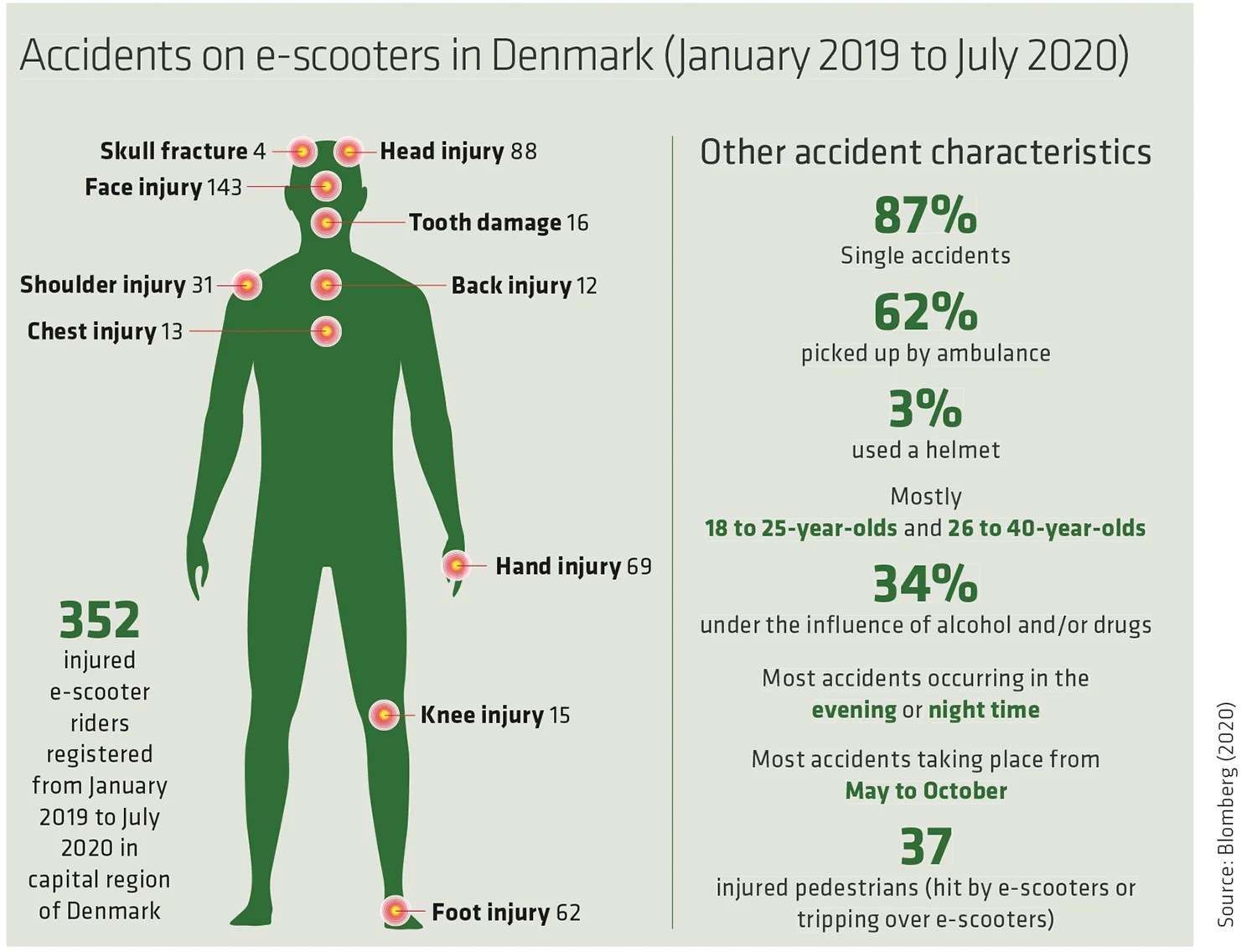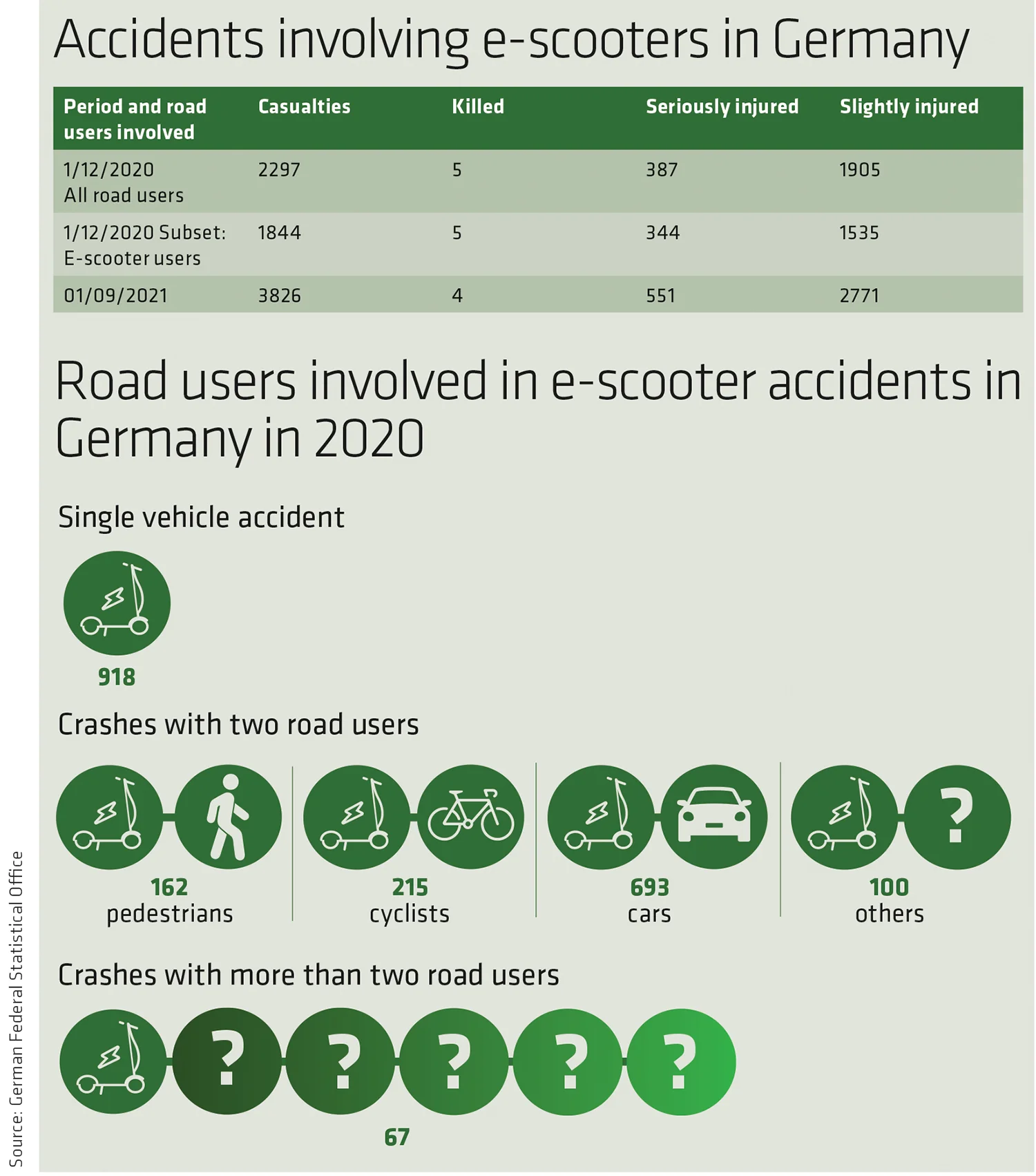
Analysis: E-scooters – the view from Europe

As UK e-scooter trials are extended, Post looks at what lessons the UK could learn from its European neighbours
The Department for Transport has extended e-scooter trials for the second time, most recently to the end of November 2022. It is understood this is to allow the government department to fill data gaps and collect more evidence before policy and legislation is put in place.
The first e-scooter trial in the UK was launched in Middlesborough in July 2020 and pilot schemes are now operational in 32 areas in England. Private e-scooters remain illegal to use on the UK’s roads and have not been included in a recent Highway Code update.
In Europe more widely, some countries have allowed e-scooters on roads since 2017, with very different approaches taken across the continent.
Speaking at a European Transport Safety Council event on e-scooter safety on 25 January, Sarah Lynch, policy officer at the European Commission said: “The legal framework is very fragmented between and even within countries. That makes it confusing for people who visit other cities to know ‘is it the same as my hometown’ or maybe it’s more difficult for operators that want to operate in different countries to know what the legal provisions are.
“That’s the reason why the commission is interested, not to say that we have a direct role, but as a guiding influence.”
While the European Commission could play a role in guidance towards national, regional and even city level authorities, Lynch pointed out that the commission has “limited competence when it comes to harmonising traffic rules”.
Uncertainty
After allowing e-scooters to run mostly unregulated, Sweden and Norway took steps to cut back on the number of licensed operators with Stockholm’s Vice-Mayor for Traffic Daniel Helldén saying the situation had “become too chaotic” after residents grew tired of pavements being blocked by abandoned e-scooters. Finland also introduced a night time curfew to get the volume of e-scooters down after Helsinki doctors called for a ban following a rise in related accident admissions.
Belgium has introduced special parking areas, speed limits and fines if the vehicles are dumped in the street after e-scooters led to a spike in accident rates when first introduced in Brussels.
Italy recently updated its Highway Code to introduce tighter restrictions for e-scooters, including a reduction in the maximum speed from 25 kilometres per hour (equivalent to around 15.5mph) to 20kph and 6kph in pedestrian areas. It also banned the use of e-scooters on pavements unless pushed by hand and introduced designated parking areas.
The country’s crackdown on e-scooters comes after the death of a 13-year-old boy who suffered head injuries in an accident in Sesto San Giovanni, northern Italy, where mayor Roberto Di Stefano reacted by cutting speed limits.
After a number of accidents involving e-scooters (see box, p16), France, Germany and Sweden have also imposed 20kph speed restrictions, with France and Germany banning driving on pavements. However, many countries continue to maintain 25kph limits.
View from Denmark
Denmark’s capital city Copenhagen banned all free-floating rental companies for a year in October 2020, with residents and visitors only able to rent e-scooters from companies with physical shops.
Speaking at the ETSC event, Bjørn Olsson, documentation consultant at the Danish road safety council (Rådet for Sikker Trafik), said: “The Danish Road Safety Council was quite sceptical of allowing these vehicles in our road traffic due to road safety concerns.”
E-scooters were described as causing “chaos” by residents in Copenhagen, and a “hassle” to the elderly and disabled, Olsson said.
He continued: “In 2020 there was an interim evaluation of e-scooters and it showed that the risk-per-vehicle-mile-driven of riding on a scooter was seven times higher than for cycling [...] and along with negative press coverage, this led the Minister to make new rules that enabled city councils to regulate the rental markets for the e-scooters in terms of parking and allowing city councils to have caps on the number of rental lease contracts.
“Copenhagen municipality quickly took advantage of that and banned [free-floating] e-scooter operators in Copenhagen altogether. Meaning that for most of 2021 there were almost no e-scooters in Copenhagen [...] then in October 2021 rental e-scooters were again allowed but only in parts of Copenhagen.”
Olsson added that now e-scooter riders in Copenhagen have to wear a helmet, with a €200 (£167) fine for failure to comply. The city also has strict rules around where e-scooter can and cannot be parked.
E-scooter riders in Copenhagen have to wear a helmet, with a €200 fine for failure to comply. The city also has strict rules around where e-scooter can and cannot be parked
He said: “E-scooters are legalised through a pilot scheme legislation, that means that rules can quite quickly be changed by the Minister of Transport. It’s actually the same type of legislation that is put in place for new modes of transport such as speed pedelecs.
“One of the most important [rules] is that you have to be at least 15 years-old to ride an e-scooter in Denmark, there are exceptions if you are accompanied by an adult.
“At the Danish Road Safety council we believe that is not an ideal situation, because in practice that means that as an eight-year-old you could be travelling e-scooter alone or with an adult next to you so it makes rules blurry.”
The current speed limit for e-scooters in Denmark is 20kph. However, Olsson highlighted: “We were actually considering whether it would be better to have a speed limit of 18kph or 17kph given the higher risk of e-scooters compared to cycling.”

View from France
France has created a new category for the e-scooters that can be ridden by those aged 12 and over without a licence at speeds up to 25kph. Under new rules, insurance will also be mandatory for e-scooter riders; however, licence plates will not be required. Helmets and hi-vis vests are also not compulsory but recommended.
Before e-scooter legislation in France was introduced in October 2019, there was no official status for e-scooters.
In France, under new rules, insurance will be mandatory for e-scooter riders; however, licence plates will not be required and helmets and hi-vis vests are also not compulsory
Vianney Sotteau, underwriter at French insurtech Luko, recalled to Post: “We didn’t know in which category of vehicle it fell into. The legal framework was not ready for it so we didn’t know if we should consider it as a car or motorbike or a bike. It was a confusing situation. There were a lot of questions about it such as are they allowed to drive on the sidewalk or are they supposed to dive on the road? Is it allowed to park on the sidewalk? Is there any maximum speed? Should they have any protection?
“At the time there was no insurance product that existed and our company was the first to sell this product in the French market even before the legal framework was clarified in October 2019.”
Sotteau pointed out that while there were no rules around e-scooters there was risk and “as long as there’s a risk we’ll insure it”.
He said: “The law classified these as motor vehicles, so it goes into the same category as cars and motorbikes, so insurance is mandatory. If you buy an e-scooter you have to have insurance, at least for liability. In France insurance provides protection to victims, and victims could be anyone walking on pavement or walking the street.”
While the law is clear, with riders still driving e-scooters uninsured an increase in accidents and parking issues is being seen in France.
Sotteau said that it is important that if there is a new type of vehicle “then the government should make a law quicker rather than later to avoid any situation where we don’t know what to do”.
It is not just France that has found the introduction of e-scooters at times unwieldy and confusing.
View from Germany
In Germany, electric vehicles are under the motor vehicle category, which means they have the same alcohol limit as cars and require insurance. E-scooters in Germany must be designed with a maximum speed of 20kph and fitted with a bell and lighting similar to a bike.
An evaluation is ongoing, meaning further reform could yet happen into 2023.
In 2020 there were 2297 casualties, five killed, 287 seriously injured and 1905 slightly injured in accidents involving e-scooters, according to Germany’s road safety council. For the first nine months of 2021 this had risen to 3826 casualties, with four people killed in incidents involving e-scooters.
All five fatalities in 2020 were e-scooter riders – and e-scooter riders themselves accounted for more than 80% of casualties in associated accidents.
In Germany, electric vehicles are under the motor vehicle category, which means they have the same alcohol limit as cars and require insurance
Tanja Hohenstein, public affairs advisor for cycling and pedestrian policy at the German road safety council (Deutscher Verkehrssicherheitsrat), said at the ETSC event: “The main mistakes which were made by users were drink driving - almost 20% of the misbehaviour that was recorded and linked to accidents. This was followed by the wrong use of the road and unadapted speed.”
She added the main known accidents include loss of control, turning into a road or crossing it and accidents between vehicles moving along in carriageway.
Hohenstein described results of a survey on e-scooter use: “We found that over 50% were not aware of the blood alcohol limits. Many people didn’t know that they were not supposed to use sidewalks and there was confusion about the minimum age.”
In order to educate the public to help prevent accidents from happening, in 2020 the German Road Safety council started a campaign called Ride Without Risk. This was written in both German and English to widen its reach to international tourists.
In addition to improving infrastructure, Hohenstein said recommendations or further ideas from the German experience could include reconsidering making indicators mandatory, with accidents involving turning into roads among the main accident types seen, as well as reconsidering automatic speed limits and potentially bringing in a ‘beginner mode’.

Different countries may have taken their own approaches, but experts do think there could be benefits from more Europe-wide guidance, particularly for countries with less resources to put towards monitoring pilots or the introduction of e-scooters
Moving forwards
Different countries may have taken their own approaches, but experts do think there could be benefits from more Europe-wide guidance, particularly for countries with less resources to put towards monitoring pilots or the introduction of e-scooters.
ETSC policy director Ellen Townsend set out: “At the moment member states, and cities as well, are looking around to see [what is happening in different countries] so we would very much like to have some guidance for national levels for things such as helmets, minimum age, passengers, insurance, minimum training, the entire package beyond what we have now.”
View from the UK
Christopher Oldfield, partner at Kennedys, believes the extension of the trials in England means the government still does not know what the “correct regulatory framework” should be to ensure safe use of private and rental e-scooters on the roads.
He set out: “[The government] has clearly woken up to the fact that between 500,000 to a million private e-scooters may be used on the road of which there’s very little data. What it is trying to do now of course is get that updated via social media, the internet, police and NHS. So it looks like it is trying to plug a hole in the data.”
Ashley Easen, director of risk consulting at Gallagher Bassett, believes e-scooters have effectively been “normalised”.
She argued that the government has missed a “huge opportunity” by not mentioning e-scooters in the recent update of the Highway Code.
According to Lucie Clinch, senior associate at Stewarts Law, the UK has not been able to regulate and legislate on e-scooters quickly enough to keep up with their increasing presence.
She argued: “We are doing things the wrong way round unfortunately because the rollout has exceeded where we were in terms of putting things in place to ensure safety for everybody. Riders can just get them off the shelf in a shop and they can go pretty fast so an insurance regime like those in other countries would be a helpful. Then when people buy them they know they need to be insured and can’t just take them out on a road illegally, which is what is happening over here.”
Policing is another area where the UK could learn from other countries.
Clinch said: “France is dedicating more resources to policing and checking for speed. Additionally restricted areas are patrolled. That’s something we could be looking at if we’re going to say they’re illegal.”
While UK pilot schemes are continuing for longer than expected, DAC Beachcroft partner Peter Allchorne believes that the decision to start with the trials was the “right way to do it”.
He set out: “The Republic of Ireland has taken a completely different view, when effectively it is going to legalise them, and then it is going to look at how that operates and what that actually means in practice. It’s a complete reverse from the way that the UK has taken. The position the UK government has taken is probably the right one.”
However, he caveated: “But the longer it goes on that the bigger the problem it is creating because the big challenge is the more of these are on the road, the harder [it is] to enforce infringements and they’re hard to enforce anyway by virtue of the type of device that they are.”
Ian Slater, partner at DWF, said: “Different countries, different cities, different cultures… it is difficult if not impossible to suggest that there should be uniformity across Europe and wider. These are social mobility products designed to assist with short journeys. Each city will, therefore, have its own pressures and individual set of circumstances which need to be catered for locally.
“Having said that we do believe that there should be a minimum baseline of regulation with local variations applied over and above those,” he concluded.
Only users who have a paid subscription or are part of a corporate subscription are able to print or copy content.
To access these options, along with all other subscription benefits, please contact info@postonline.co.uk or view our subscription options here: https://subscriptions.postonline.co.uk/subscribe
You are currently unable to print this content. Please contact info@postonline.co.uk to find out more.
You are currently unable to copy this content. Please contact info@postonline.co.uk to find out more.
Copyright Infopro Digital Limited. All rights reserved.
As outlined in our terms and conditions, https://www.infopro-digital.com/terms-and-conditions/subscriptions/ (point 2.4), printing is limited to a single copy.
If you would like to purchase additional rights please email info@postonline.co.uk
Copyright Infopro Digital Limited. All rights reserved.
You may share this content using our article tools. As outlined in our terms and conditions, https://www.infopro-digital.com/terms-and-conditions/subscriptions/ (clause 2.4), an Authorised User may only make one copy of the materials for their own personal use. You must also comply with the restrictions in clause 2.5.
If you would like to purchase additional rights please email info@postonline.co.uk








